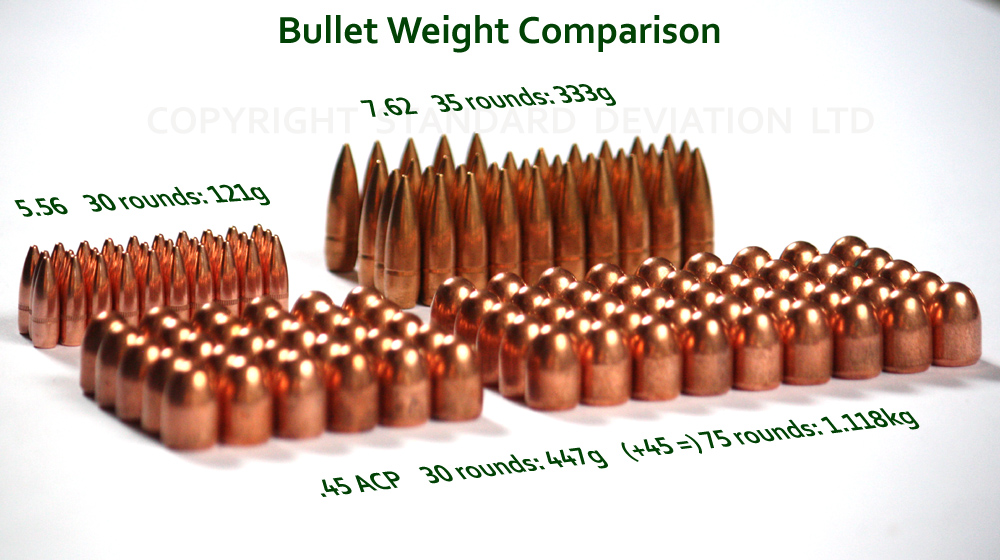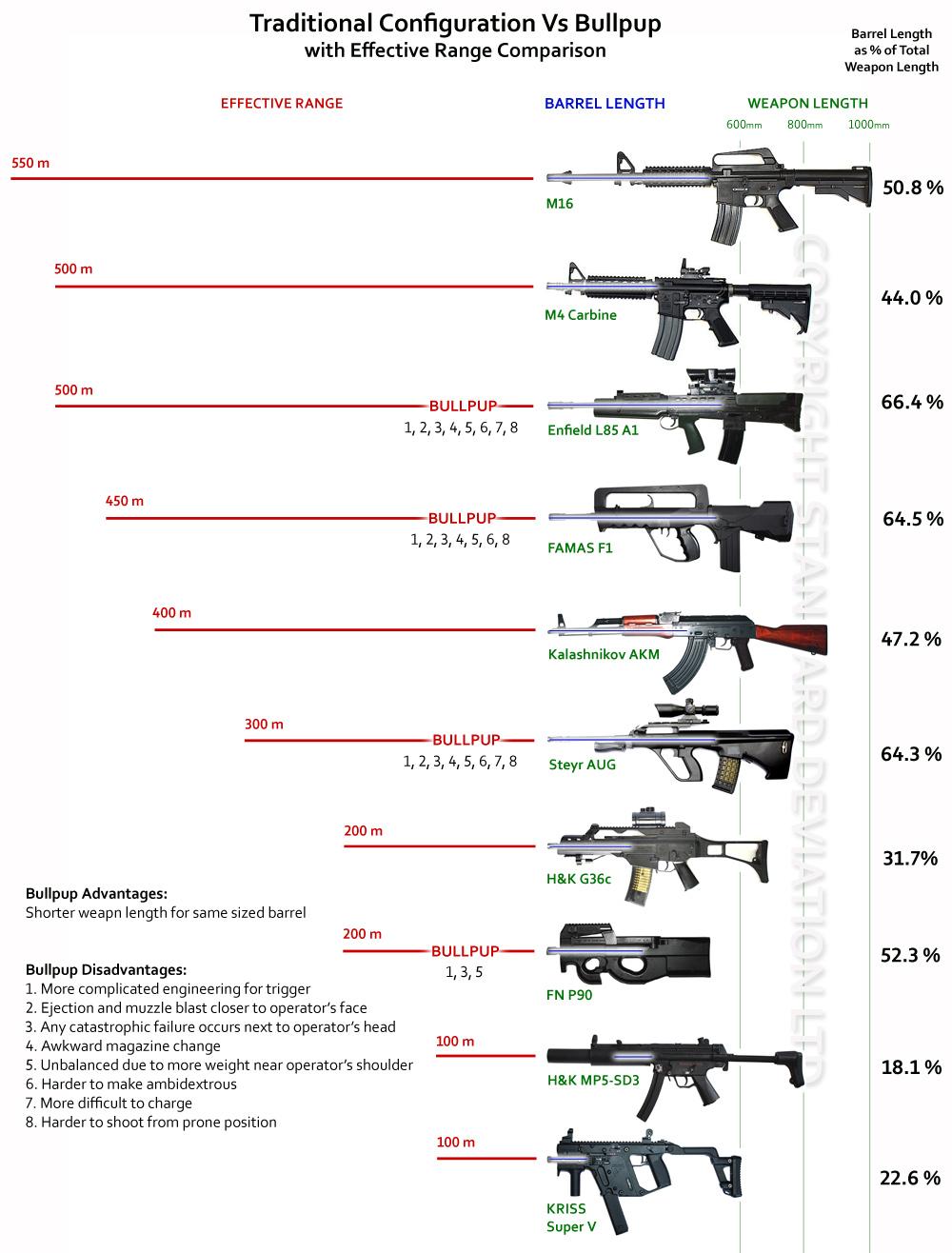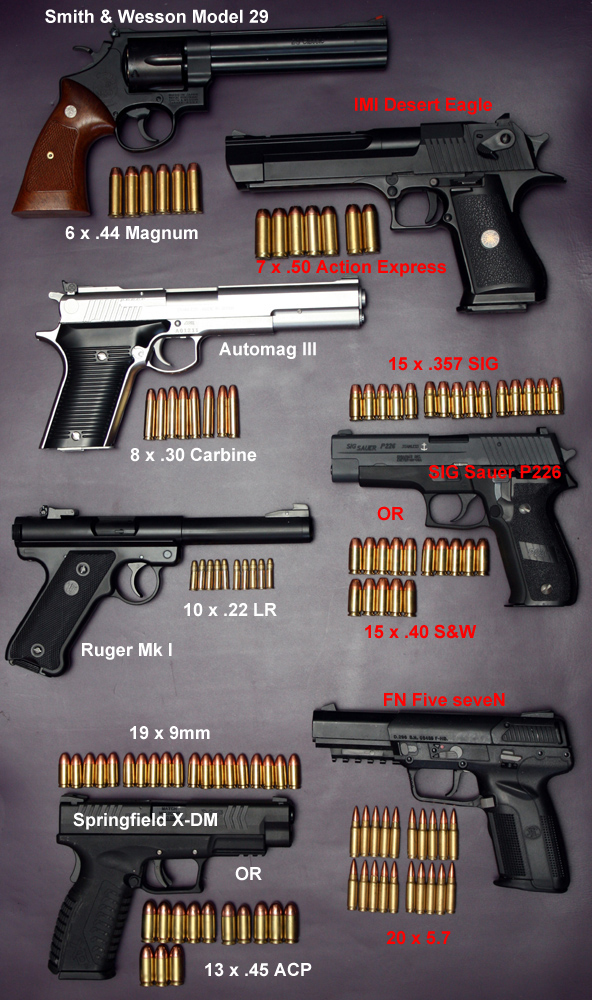There are links above to other pages detailing various bullets and iconic firearms
Contents:
- Select Fire Innovations
- Comparison of Automatic Weapon Effectiveness
- Comparison of Pistol Effectiveness
- Pistol Timeline
- Traditional vs Bullpup Configurations
1. Select Fire Innovations
Below I have listed various weapons that can switch between single, burst or automatic fire (select fire) with their innovations and influential aspects. These are firearms that were ahead of their time.

2. Comparison of Automatic Weapon Effectiveness
The following attempts to show how effective various automatic weapons are by comparing their "Effective Range", their Calibres and their Rate of Fire.
There are several points to note about the graphs and figures present in this next image.
Since most automatic weapons exhaust their magazine within 3 seconds of constant fire, I have detailed how many rounds they can put downrange in that 3-second burst.
Note: If their rate of fire exceeds a magazine in that time, I have assumed they could not realistically reload another magazine, aim and fire so the amount shown is one magazine.
The thickness (height) of the Pink bar indicates how much metal each weapon can put downrange, as a total weight in kgs of all the bullets fired in a 3 second burst. The efective range of each weapon is indicated by how long the Pink bar is.
The Green bar gives a relative indication of the weight of each weapon.

Here is an indication of what those numbers of bullets looks like:

3. Comparison of Pistol Effectiveness
The following image shows various pistols and the potential magazine loads they can deliver. There is no formula or comparative indicator to say one pistol calibre is more lethal than another.
|
Any bullet can kill if placed appropriately. Death occurs when the brain is deprived of oxygen or the central nervous system itself is damaged significantly. Typically this is caused by directly hitting the brain or upper spinal column, or by a loss in blood pressure or lung function that prevents oxygenated blood reaching the brain. The one single major factor in how lethal a round will be, is placement. Attempts by ammunition companies and uneducated shooters to apply some mythical "stopping power", "shock" or "killing power" to specific bullets is misleading at best, and mostly farcical. The "Taylor KnockOut Factor" formula is one of the more common ones, but it is still useless. The only killing power any bullet has is the ability to create a permanent cavity and decrease blood pressure as quickly as possible. (In some instances a sudden increase in blood pressure caused by a bullet's cavitational force can also cause catastrophic hemorrhage in the brain of the victim.) You can't predict how a person's body will react to a bullet even if you know their health, weight and state. You can however compare bullets with regards to penetration, velocity and deformation pattern. Typically a blunter bullet with more weight will penetrate further and cause a bigger permanent cavity. The graphic (left) might give you an idea of which pistol and calibre combination offers a shooter the highest chance of placing a lethal combination of rounds into their target. Greg Ellifritz spent 10 years collating real data on shootings and has some interesting conclusions in his article An Alternate Look at Handgun Stopping Power |
Note: I have included only a subset of pistols with different calibres which have the highest number of rounds for each calibre in their standard magazine.
Additionally, this link is a great read if you want to learn about 'The Mechanics of Terminal Ballistics'
4. Pistol Timeline
The pistols I have are shown here by date of manufacture on a timeline of the last 100 years (or thereabouts) mapped against dates of some major conflicts happening at the time.
Interestingly the M1911 is the basis for the majority of modern pistols and that same basic design is in use by Police, Military and civilian around the world today, despite being over 100 years old.
Most modern pistols differ in weight from earlier models due to advancements in polymers. They also tend to be more ergonomic and compact, with rails for attachment options like torches and laser sights. 9mm pistols are the most common today although many makes and models are also chambered for more recent and powerful calibres than the 9x19mm Parabellum round, which is now over 120 years old .
5. Bullpup and Traditional Configurations
So many modern assault rifles are taking on a bullpup configuration for the sake of a shorter weapon that it raises several questions about the future of traditional configurations. Why do modern armies, such as the US forces, continue to use traditional weapon configurations?

The conclusion would appear to be that bullpups are only advantageous in situations where the length of a weapon is critical, such as being carried or fired from the inside of a vehicle or in very close quarter battles. In both these situations a traditional weapon may not be feasible or be so awkward as to put the operators at high risk.
From this (short) list of bullpups, only the FN P90 has been designed to avoid many of the pitfalls that bullpups often fall into. It was originally meant to be used as a Personal Defence Weapon (PDW) but its design advantages led to its use in other roles by Special Forces and Police Forces.

